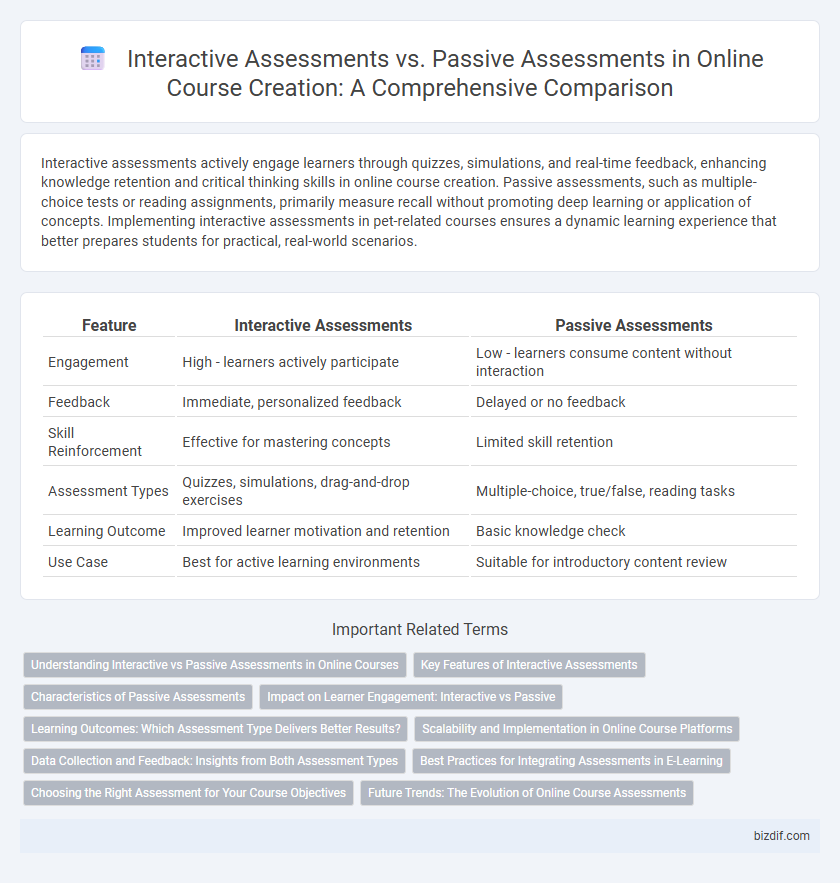Interactive assessments actively engage learners through quizzes, simulations, and real-time feedback, enhancing knowledge retention and critical thinking skills in online course creation. Passive assessments, such as multiple-choice tests or reading assignments, primarily measure recall without promoting deep learning or application of concepts. Implementing interactive assessments in pet-related courses ensures a dynamic learning experience that better prepares students for practical, real-world scenarios.
Table of Comparison
| Feature | Interactive Assessments | Passive Assessments |
|---|---|---|
| Engagement | High - learners actively participate | Low - learners consume content without interaction |
| Feedback | Immediate, personalized feedback | Delayed or no feedback |
| Skill Reinforcement | Effective for mastering concepts | Limited skill retention |
| Assessment Types | Quizzes, simulations, drag-and-drop exercises | Multiple-choice, true/false, reading tasks |
| Learning Outcome | Improved learner motivation and retention | Basic knowledge check |
| Use Case | Best for active learning environments | Suitable for introductory content review |
Understanding Interactive vs Passive Assessments in Online Courses
Interactive assessments in online courses actively engage learners through quizzes, simulations, and real-time feedback, enhancing knowledge retention and critical thinking. Passive assessments, such as multiple-choice tests or essays, primarily evaluate comprehension without immediate learner involvement or adaptive responses. Understanding the differences between interactive and passive assessments is crucial for designing effective online courses that promote deeper learning and continuous improvement.
Key Features of Interactive Assessments
Interactive assessments feature real-time feedback, adaptive question paths, and multimedia integration to actively engage learners and enhance knowledge retention. These assessments allow for dynamic response analysis, enabling personalized learning experiences based on individual performance. Unlike passive assessments, they encourage critical thinking and continuous learner participation through simulations, quizzes, and scenario-based tasks.
Characteristics of Passive Assessments
Passive assessments in online course creation primarily involve activities such as multiple-choice quizzes, true/false questions, and reading comprehension tests where learners receive information passively. These assessments are typically easy to administer and grade, relying on rote memorization and recall rather than critical thinking or problem-solving skills. They often lack real-time feedback and interactive elements, reducing learner engagement and limiting the depth of knowledge retention.
Impact on Learner Engagement: Interactive vs Passive
Interactive assessments significantly enhance learner engagement by promoting active participation and real-time feedback, which deepens understanding and retention of course material. Passive assessments, such as multiple-choice quizzes without immediate feedback, often result in lower motivation and reduced cognitive involvement, limiting the effectiveness of learning. Incorporating interactive elements like simulations, drag-and-drop exercises, and scenario-based questions fosters critical thinking and sustained attention, leading to improved educational outcomes.
Learning Outcomes: Which Assessment Type Delivers Better Results?
Interactive assessments enhance learning outcomes by actively engaging students through quizzes, simulations, and real-time feedback, fostering deeper understanding and retention of material. Passive assessments, such as multiple-choice tests or readings, often fail to stimulate critical thinking or application of knowledge, resulting in lower retention and limited skill development. Studies show that courses incorporating interactive assessments see up to 30% higher achievement in knowledge retention and skill mastery compared to passive assessment methods.
Scalability and Implementation in Online Course Platforms
Interactive assessments enhance online course scalability by enabling automated, real-time feedback and adaptive learning pathways, reducing instructor workload while maintaining engagement. Passive assessments, such as quizzes and multiple-choice tests, are easier to implement but offer limited scalability in personalized learning experiences. Modern online course platforms like Moodle and Canvas support both assessment types with varying degrees of integration complexity and scalability potential.
Data Collection and Feedback: Insights from Both Assessment Types
Interactive assessments enable real-time data collection by tracking learner responses and engagement metrics, offering immediate, actionable feedback to both instructors and students. Passive assessments, such as quizzes or exams graded after completion, provide cumulative data that helps identify overall knowledge gaps but lack instant adaptability. Combining insights from both methods enhances course effectiveness by balancing immediate learning adjustments with long-term performance analysis.
Best Practices for Integrating Assessments in E-Learning
Interactive assessments, such as quizzes with immediate feedback and scenario-based tasks, enhance learner engagement and knowledge retention by actively involving students in the learning process. Passive assessments like multiple-choice tests without feedback may measure recall but often lack the ability to reinforce learning or identify misunderstandings in real time. Best practices for integrating assessments in e-learning emphasize incorporating varied interactive elements aligned with learning objectives, timely feedback, and adaptive difficulty to support personalized learning paths and improve overall course effectiveness.
Choosing the Right Assessment for Your Course Objectives
Interactive assessments actively engage learners through quizzes, simulations, and real-time feedback, enhancing knowledge retention and practical skill application. Passive assessments, such as multiple-choice tests or essays, primarily evaluate recall and comprehension without immediate learner interaction. Selecting the appropriate assessment type depends on course objectives: use interactive assessments to foster critical thinking and skill development, while passive assessments effectively measure foundational understanding and content retention.
Future Trends: The Evolution of Online Course Assessments
Future trends in online course assessments emphasize a shift from passive assessments, such as multiple-choice quizzes, to interactive assessments that actively engage learners through simulations, real-time feedback, and adaptive testing. The evolution leverages AI-driven analytics and immersive technologies like VR to enhance learner participation, retention, and personalized learning paths. These interactive assessments foster deeper understanding and better skill application, positioning them as the next standard in online education effectiveness.
Interactive Assessments vs Passive Assessments Infographic

 bizdif.com
bizdif.com